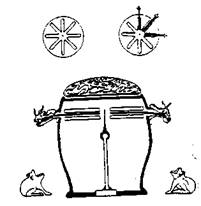home
 Economy Economy
 Books Books
 History of the world economy - Polyak GB History of the world economy - Polyak GB
|
History of the world economy - Polyak GB
The science
Such a level of state of agriculture, crafts and construction was possible only with the very high development of science and technology for its time.
Already in the middle of the II millennium BC. E. In China appears writing in the form of hieroglyphs-pictograms (pictures). Individual words were denoted by drawings. Then the hieroglyphs began to denote concepts.
The needs of everyday life have caused the emergence of knowledge in the field of mathematics. In the Shan era, the Chinese already possessed knowledge in geometry, in particular, they knew the properties of a right-angled triangle, and so on.
The need to compile a calendar has become the basis for the development of astronomical knowledge. In II thousand Chinese astronomers not only developed a calendar, but could calculate and predict solar and lunar eclipses, made a map of the starry sky.
The authorities supported and encouraged the development of scientific knowledge. In the first Chinese university, established in the II. BC. E. In Luoyang, there were 50 students, and by the beginning of the 1st c. N. E. About 3,000 people have already studied here. In the III century. N. E. A national academy was organized.
The Chinese gave the world a number of outstanding inventions, having a great impact on many aspects of life and people's activities. In the III century. BC. E. The Chinese made the geographical maps of the Ancient East . In the II century. N. E. Inventor Zhang Heng gave the world the first seismograph, fixing earthquakes at a distance of more than 500 km.

Seismograph Chang Heng
More than two thousand years ago, the Chinese invented a compass, without which the later geographical discoveries of Europeans would not have been conceivable.
Great success was achieved by Chinese medicine. Already in the III century. BC. E, the Chinese knew the circulatory system, and at the beginning of our millennium they knew about hormones. Chinese physician Hoa Toth in the III century. N. E. Anesthetics were first used in surgical operations. And finally, from the VI. BC. E. In China, the original method of treatment - acupuncture began to be applied.
The historical background on which the development of ancient Chinese society, economy and culture took place, the outstanding achievements of ancient Chinese farmers, artisans, builders, scientists and inventors, was troubled - class contradictions, popular uprisings, economic crises have often been shaken by Ancient China.
Already during the state of Zhou in 842 BC. E. The insurgent poor and slaves stormed the palace and drove King Lee away and almost killed his son. In the III century. BC. E. The insurgent peasants captured the capital, overthrew the tsar from the Qin Dynasty, and their leader, Liu-Ban, founded a new Han dynasty. The first rulers of this dynasty reduced taxes and reduced the labor obligations of the country's population. However, further strengthening of class and economic oppression forced people to sell children into slavery in order to pay their debts. Landless peasants were forced to lease land and give the landlord 50% of the crop. Such a high level of rent led to the enslavement of free people. All this caused peasant uprisings.
In 8 AD. E. As a result of the peasant uprising van Man came to power. He carried out a series of reforms: the land of large landowners was confiscated and redistributed, large landownership was limited, the sale of land and slaves was prohibited, solid prices were established in the markets. The state established control over production and trade. However, in a few years these reforms were abolished. The uprising of the "Yellow Turban", which occurred in 184 and was suppressed, did not improve the situation of the country's population.
However, the unreasonable exploitative policy of the ruling classes of Ancient China, and as its result, the popular uprisings undermined the economic and, consequently, the military power of the state of Han and it fell under the pressure of nomads.
Questions for repetition
1. Tell us about the origins and stages of the development of the ancient Chinese state.
2. Describe the features of land use and development of agriculture in ancient China.
3. Compare the system of public administration of Ancient China with other countries of the Ancient World.
4. How did crafts and industry develop in ancient China?
5. What scientific discoveries and technical inventions in ancient China had a significant impact on economic development?


Comments
Commenting on, remember that the content and tone of your message can hurt the feelings of real people, show respect and tolerance to your interlocutors even if you do not share their opinion, your behavior in the conditions of freedom of expression and anonymity provided by the Internet, changes Not only virtual, but also the real world. All comments are hidden from the index, spam is controlled.